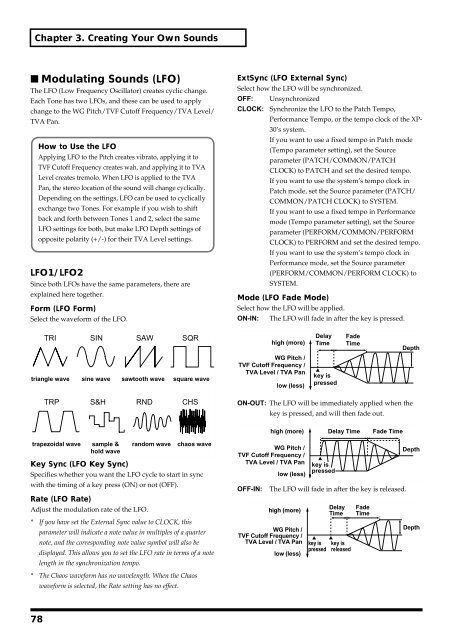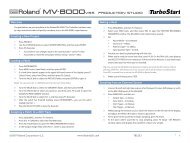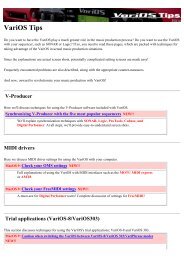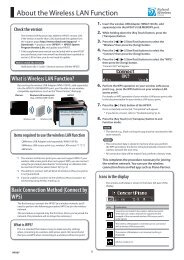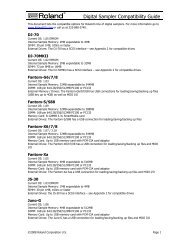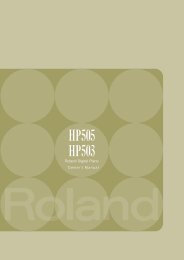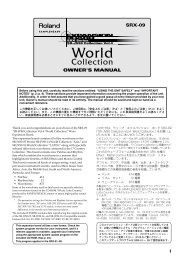You also want an ePaper? Increase the reach of your titles
YUMPU automatically turns print PDFs into web optimized ePapers that Google loves.
Chapter 3. Creating Your Own Sounds<br />
■ Modulating Sounds (LFO)<br />
The LFO (Low Frequency Oscillator) creates cyclic change.<br />
Each Tone has two LFOs, and these can be used to apply<br />
change to the WG Pitch/TVF Cutoff Frequency/TVA Level/<br />
TVA Pan.<br />
How to Use the LFO<br />
Applying LFO to the Pitch creates vibrato, applying it to<br />
TVF Cutoff Frequency creates wah, and applying it to TVA<br />
Level creates tremolo. When LFO is applied to the TVA<br />
Pan, the stereo location of the sound will change cyclically.<br />
Depending on the settings, LFO can be used to cyclically<br />
exchange two Tones. For example if you wish to shift<br />
back and forth between Tones 1 and 2, select the same<br />
LFO settings for both, but make LFO Depth settings of<br />
opposite polarity (+/-) for their TVA Level settings.<br />
LFO1/LFO2<br />
Since both LFOs have the same parameters, there are<br />
explained here together.<br />
Form (LFO Form)<br />
Select the waveform of the LFO.<br />
fig.3-36.e<br />
TRI SIN SAW SQR<br />
triangle wave sine wave sawtooth wave square wave<br />
TRP S&H RND CHS<br />
ExtSync (LFO External Sync)<br />
Select how the LFO will be synchronized.<br />
OFF: Unsynchronized<br />
CLOCK: Synchronize the LFO to the Patch Tempo,<br />
Performance Tempo, or the tempo clock of the XP-<br />
30’s system.<br />
If you want to use a fixed tempo in Patch mode<br />
(Tempo parameter setting), set the Source<br />
parameter (PATCH/COMMON/PATCH<br />
CLOCK) to PATCH and set the desired tempo.<br />
If you want to use the system’s tempo clock in<br />
Patch mode, set the Source parameter (PATCH/<br />
COMMON/PATCH CLOCK) to SYSTEM.<br />
If you want to use a fixed tempo in Performance<br />
mode (Tempo parameter setting), set the Source<br />
parameter (PERFORM/COMMON/PERFORM<br />
CLOCK) to PERFORM and set the desired tempo.<br />
If you want to use the system’s tempo clock in<br />
Performance mode, set the Source parameter<br />
(PERFORM/COMMON/PERFORM CLOCK) to<br />
SYSTEM.<br />
Mode (LFO Fade Mode)<br />
Select how the LFO will be applied.<br />
ON-IN: The LFO will fade in after the key is pressed.<br />
fig.3-37.e<br />
high (more)<br />
WG Pitch /<br />
TVF Cutoff Frequency /<br />
TVA Level / TVA Pan<br />
low (less)<br />
Delay<br />
Time<br />
key is<br />
pressed<br />
Fade<br />
Time<br />
Depth<br />
ON-OUT: The LFO will be immediately applied when the<br />
key is pressed, and will then fade out.<br />
fig.3-38.e<br />
high (more)<br />
Delay Time<br />
Fade Time<br />
trapezoidal wave<br />
sample &<br />
hold wave<br />
random wave<br />
chaos wave<br />
Key Sync (LFO Key Sync)<br />
Specifies whether you want the LFO cycle to start in sync<br />
with the timing of a key press (ON) or not (OFF).<br />
Rate (LFO Rate)<br />
Adjust the modulation rate of the LFO.<br />
* If you have set the External Sync value to CLOCK, this<br />
parameter will indicate a note value in multiples of a quarter<br />
note, and the corresponding note value symbol will also be<br />
displayed. This allows you to set the LFO rate in terms of a note<br />
length in the synchronization tempo.<br />
WG Pitch /<br />
TVF Cutoff Frequency /<br />
TVA Level / TVA Pan<br />
OFF-IN:<br />
fig.3-39.e<br />
low (less)<br />
key is<br />
pressed<br />
The LFO will fade in after the key is released.<br />
high (more)<br />
WG Pitch /<br />
TVF Cutoff Frequency /<br />
TVA Level / TVA Pan<br />
low (less)<br />
key is<br />
pressed<br />
Delay<br />
Time<br />
key is<br />
released<br />
Fade<br />
Time<br />
Depth<br />
Depth<br />
* The Chaos waveform has no wavelength. When the Chaos<br />
waveform is selected, the Rate setting has no effect.<br />
78


